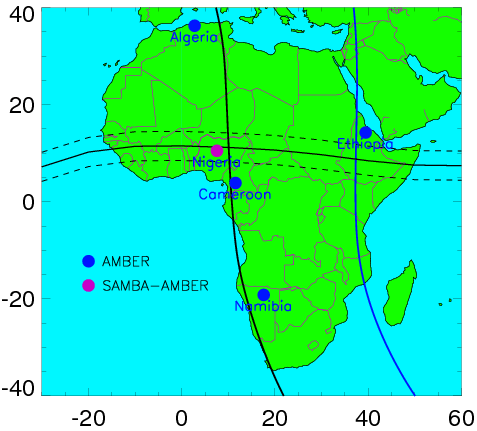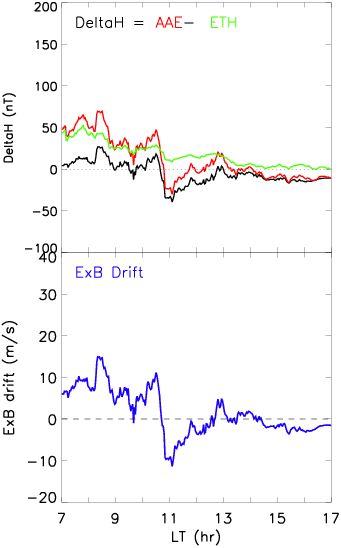African Meridian B-Field Education and Research (AMBER)PIs: E. Yizengaw. (Boston College) and M. Moldwin (University of Michigan)Objectives of AMBER 
The AMBER magnetometer array is comprised of four magnetometer. All of them are already stationed in Adigrat in Ethiopia, Algiers in Algeria, Yaounde in Cameroon, and Tsumeb in Namibia. Recently, in colaboration with SAMBA project, the fifth magnetometer, known as AMBER-SAMBA magnetometer, has been deployed in Abuja, Nigeria. The Figure shows the location of AMBER and SAMBA-AMBER magnetometer network. The specific location of each stations is shown in Table 1.
While polar-cap to equatorial coverage exist in the American meridian with the deployment of McMAC array linking the expanded Canadian CARISMA (formerly CANOPUS) and the SAMBA arrays, in Europe the coverage essentially ends with SEGMA in Italy. AMBER array is now connecting the European magnetometer array to low latitudes by filling the largest land-based gap in global magnetometer coverage in Africa, as is shown in the Figure above. AMBER stations in Algiers, Abuja, Yaounde, and in Tsumeb will be used for connecting IMAGE-SAMNET-SEGMA array to low and dip-equator latitudes, and link up with South African Intermagnet and Antarctic magnetometers in the southern hemisphere so that we can have complete meridian observation in the region. In addition to filling the largest land-based gap in global magnetometer coverage, the AMBER array will address two fundamental areas of space physics: (1) the processes governing electrodynamics of the equatorial ionosphere as a function of latitude (or L-shell), local time, longitude, magnetic activity, and season, and (2) ULF pulsation strength and its connection with equatorial electrojet strength at low/mid-latitude regions. 
In coordination with GPS receivers in Africa, AMBER magnetometer array will provide a great opportunity to understand the electrodynamics that governs equatorial ionosphere motions. By combining AMBER in Adigrat (~6.0 N magnetic) and INTERMAGNET in Addis Ababa (~0.13 N magnetic) for east-african sector and AMBER in Yaounde (~5.9 S magnetic) and SAMBA-AMBER in Abuja (~0.55 S magnetic) for west-African sector, the strength of equatorial electrojet (EEJ) and thus vertical ExB drift is routinely estimated using a well known pair of magnetometers drift estimation technique. Therefore, while the magnetometers routinely observe the F region plasma drift mechanism (ExB drift), the GPS stations will monitor the structure of plasma at low/mid-latitudes in the African sectors. Such combined observations provide enormous opportunity to understand the unique equatorial ionospheric structures in the African sector that have been often detected by satellite observations. In addition to new scientific discoveries and advancing the space science research into Africa by establishing scientific collaborations between scientists in the developing and developed nations, the AMBER project also contributes to the effort in developing the basic science of heliophysics through cross disciplinary studies of universal process. This includes the creation of sustainable research/training infrastructure within the African universities. This will then create opportunities for undergraduate students to enhance their inspiration to space science and perform research activities in the future within their own countries. Data from AMBER magnetometer array will be directly accessible to space weather forecasters and the space science community at large. AMBER Home Page |